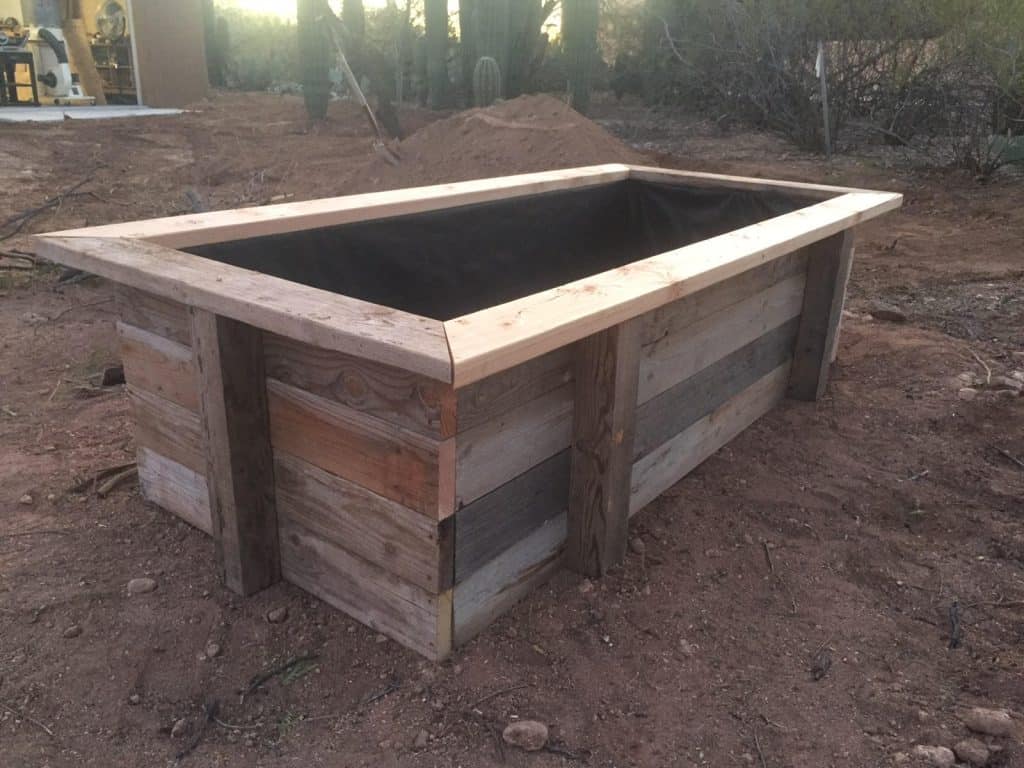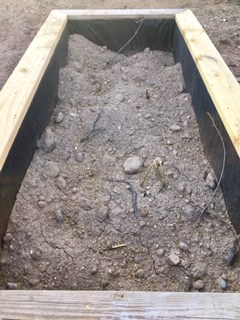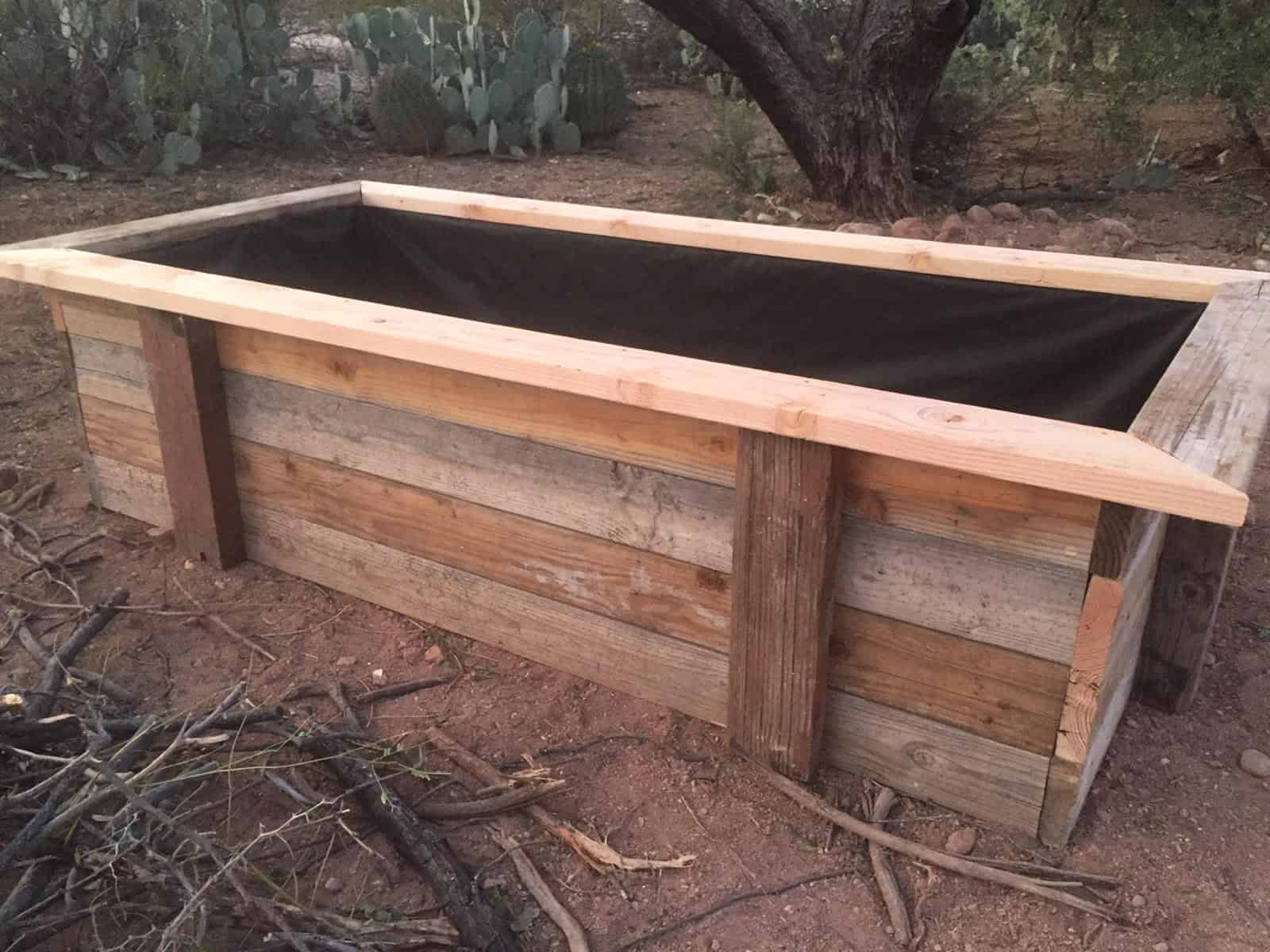Last Updated on October 10, 2024 by Alice Benny
Building a raised garden bed cheaply will give you more gardening opportunities and options. They are a great addition because they provide alternatives to in-ground gardening.
Garden beds can be any size and are ideal for areas with small spaces such as balconies or a rooftop. They also help gardeners grow in areas with poor soil.
Also, building a raised garden bed doesn’t have to cost a lot of money. It can be an inexpensive and somewhat simple process if you have or can borrow the tools. Using reclaimed wood makes it inexpensive as well. You can even use cinder blocks to build a garden bed.
I wanted to share my husband’s experience building a DIY raised garden bed.
How to build a raised garden bed cheaply
Before you buy materials, it’s important to consider a few things.
Determining the location
If you have a backyard or some land, you will have more options than someone with a small space. Some things to consider are:
- Level ground / flat surface
- Sun direction
- Water source
In the northern hemisphere, most gardeners suggest a south-facing garden. However, it’s important to consider your climate and what you will be growing.
Some fruits and vegetables do well in full sun while others do not.
In our situation, living in the desert in the southwestern United States, we situated ours so it won’t be in full summer sun.
You will also want to consider taller plants that may block sun from shorter/smaller ones.
Also consider how far away the water source will be. Will you have the ability to run a hose to a farther area on your property? Will you want to walk far with a watering can each time you water the garden?
In our situation, we located ours within 20 feet of our water cistern. We have a 2,600 gallon rainwater harvesting tank. Locating the raised garden bed near the water makes it convenient for us to use it.
In time, we will add a drip irrigation system to the garden bed, making it even more convenient.
How deep should a raised garden bed be?
At a minimum, your garden bed should be 6 – 8 inches deep. Having 12″ of soil will be better to encourage healthy roots. Keep this in mind if you want to grow potatoes, carrots and other underground produce.
Potatoes in planters: How to Grow Potatoes in Pots
Before building, think about what you want to grow. Learn about those plants and the ideal depth for them.
The best height for a raised garden bed will depend on your access to good quality soil and costs you may need to incur to fill the garden bed.
Tools for DIY raised garden bed
Think about what tools you have and what you might be able to borrow.

If you plan to build additional garden beds or work on other woodworking projects, you may want to buy your own saws. For the garden bed, he used a 12 inch sliding miter saw.
My husband looked on Craigslist for tools. He ended up buying several tools from one owner at an estate sale. Look online before you buy new tools. Also consider if you can go to someone’s garage to cut the wood, etc.
For this DIY raised garden bed, he used these tools:
- Circular saw
- Miter saw
- Drill
Additional tools he used to build the garden bed were:
- Wood screws and deck screws
- Speed square
- Eye protection, ear protection
- Work gloves
- Tape measure
- Wood glue
- Pencil
- Staple to secure the liner
DIY raised garden bed plans
It’s important to know that with any DIY garden bed plans, you can make changes to fit your needs and the materials you have. For example, my husband had leftover deck screws so he used them as well as the wood screws. He didn’t have nails but he could have used those instead of, or in addition to, the screws.
Remember, this is a flexible and forgiving project. It doesn’t have to be perfect!

How to build a raised garden bed cheaply
Look for materials you already have. You can build a raised garden bed from cinder blocks. You can build a raised garden bed with bricks. My husband wanted to build a garden bed from wood with 2×6’s from another project.
In addition, he had a pile of reclaimed wood from our neighbor’s old porch he helped tear down.
If you can repurpose materials, that will make it inexpensive as well as eco-friendly.
As stated above, use whatever appropriate tools, nails, screws, and wood you already have to make a garden bed cheaply.
Using old wood to build a raised garden bed cheaply
If you are able to use pieces of wood from an old project, that’s great. We had some leftover wood from other projects. In addition, my husband took some wood from our neighbor’s old porch they tore down.
He mostly used 2×6’s to build the garden bed. Be sure to use untreated wood for the garden. If you do have painted or treated wood, be sure it’s facing out and not in contact with the soil.
If the pieces are treated on both sides, you can always sand it down with an orbital sander.
Determining the length and width of your garden bed
Put your 2×6 boards into two piles. Group them together by longest / tallest and shortest.
Garden bed length
Of the longer boards, take the shortest piece of wood and use it to determine the length of your raised garden bed.
Garden bed width
Of the shorter boards, do the same to determine the width.
Some additional things to consider when choosing the width:
- Wide enough for two rows of planting
He wanted it at least 30″ in width to enable us to have two rows for planting.
- Consider your back; bending and reaching
In addition, he didn’t want it to be too wide. He wanted us to be able to reach all the way inside the garden bed without having to bend over too far.
How high off the ground should the garden bed be?
He raised the garden bed 22″ from the ground.
Living the the southwestern part of the United States, we have lots of critters, including rattlesnakes, javelina, pack rats, etc. We wanted the height to deter as much wildlife as possible, though we are always careful.
In addition, he built a 2×6 ledge all the way around so it functions as a bench.
He thought we could sit on it, put tools on it, and sit on it in nature with a cup of tea.

It will also work well when we harvest fruits and vegetables. We will be able to set them on the ledge.
What kind of wood should be used for raised beds?
For the sides, he used 2×6’s.
The big posts are 4×6 posts which were reclaimed and repurposed from the neighbor’s porch. He used wood screws as well as wood glue to attach the posts to give them extra support.
What type of wood you use to build the garden bed depends on a few things:
- What you already have
- Availability in your area
- The cost
- Climate where you live
The 2×6 wood pieces he had were pine and douglas fir. Our climate is dry, and rotting isn’t as much of an issue as it is in other climates.
Had he been able to access cedar or redwood planks, he would have loved them but they aren’t economical or readily available where we live.

So consider where you are and what type of wood is inexpensive and accessible.
Remember, you can build a garden bed cheaply.
Ask around if anyone has leftover wood.
Oftentimes, your neighbors may appreciate help tearing down fencing, a barn, etc. These would be good types of wood to build a garden bed with.
If you live in a damp climate, you may consider using cinder blocks for a garden bed. Then it just becomes a matter of stacking the blocks.
Using a garden bed liner
He lined the inside with a garden bed liner from the hardware store. He stapled it in the floor and sides. Using a liner will help keep the soil moist. We live in the desert and while we will be using a drip irrigation system from our rainwater cistern, our summers get really hot.
Advantages to using a liner in your garden bed
- Keep to control pests
Consider what you have growing in your area. A liner may help deter moles, pack rats, gophers, and other critters in your area.
- Poor soil
We have poor quality, desert soil. There will be no benefit to using the soil beneath our raised bed.
- Minimize weeds from growing
A garden liner acts as weed barrier cloth and will reduce the number of weeds that can grow.
- Reduce soil loss
- Helps retain moisture
What to put at the bottom of raised garden bed
It’s important to consider drainage; don’t just start filling the bottom with soil. Some considerations are where you live and what’s available easily and inexpensively. You can line the bottom with rocks. This will help provide good drainage.

What do you fill a raised garden bed with?
Something practical and inexpensive my husband did was to use old branches from our property. He also cut down some dead branches from our mesquite and palo verde trees.
By using branches and pieces of decaying wood from your yard and/or from a wood pile, you can enrich the soil as well as be eco-friendly.

He filled the bottom half of the garden bed with branches. He remembered his grandparents doing this. As the wood decays, it releases nitrogen in the soil.
In addition, it takes up space so you don’t have to spend money on additional topsoil. It also aids with drainage.
After adding the branches, he filled it 3/4 of the way with clean fill dirt.
Next, he filled the remaining 1/4 of the garden bed with good quality garden topsoil made specifically for gardening but without additional fertilizers.
He also mixed in the dirt from our compost pile. Learn how to start a compost pile near your garden.
After planting, be sure to add mulch to the top to help protect and insulate the plants and root systems.
Growing Watermelon ~ How to Grow Watermelon
Adding a drip hose inside the garden bed
Our next goal is to add a drip hose inside the garden bed and connect it to our 2,600 water harvesting cistern. We will slowly drip water on the plants. We want to continuously use the water so that as it empties, we can capture new rainfall.
Using reclaimed water for raised garden bed plants is another way to be earth-friendly and save money.

We will post about our DIY self watering raised garden beds when we complete them.
What to plant in raised garden bed
Leafy greens do really well in garden beds. However, it’s important to consider many things:
- How deep is your garden bed
- What month and season are you planting
- What does well in your hardiness zone
- Are you starting from seed or with garden-ready starts
- How much will you have to water
- Do you want flowers or fruits and vegetables
Also consider if children will be helping you plant and garden. Getting some sunflower seeds and other easy-to-grow seeds and plants will make it more fun for them. (It’s also nice for the adults to have some gardening success!)
Be sure to check out your local library to see if they have a seed library. We were able to get free seed packets from our library.
Building a raised garden bed
Putting the garden bed in the right spot
We mentioned this above but the garden bed location is essential.
Consider where the sun is.
Also, consider what might block the sun.
We purposely planned for the garden bed to be under the canopy of a mesquite tree. In the non-summer months, it will get direct sunlight.
This is ideal for our climate because the branches will keep it shaded in the summer months and will allow sun to stream through in the winter months.
Also, locating it in this spot, his thought was that while working in the garden, it will keep the direct sun off of us. It will be more enjoyable to work in it.
Advantages of a garden bed
Garden beds can be eco-friendly if you use reclaimed wood. Growing your own fruits and vegetables contribute to an environmentally friendly lifestyle. In addition, if you are able to harvest rainwater, all the better.

Inexpensive DIY raised garden bed
Easiest Vegetables to Grow: A Simple Garden Guide
Raised garden beds provide alternatives to in-ground gardening.
They can vary in size.
You can make garden beds from materials you have such as wood, bricks, or cinder blocks. This means you can build a raised garden bed cheaply.
Know that you will derive a lot of benefits from building a simple raised bed garden.
Not only are they functional and utilitarian, they can be decorative too. They can add beauty to your yard.
In addition, they are highly beneficial in areas in which the ground soil is naturally poor. A garden bed gives you options to bring in your own high quality soil. You can further enrich the soil with compost.
Raised garden beds also enable you to control the environment for the particular plants you are growing.
Best Backyard Greenhouse
Once you build your first raised garden bed, it will be that much easier to build another one. With just a few simple steps, you can build your own garden bed.Straw Bale Gardening – A Beginner’s Guide to Strawbale
Learn about pros and cons of planting in the ground vs garden bed vs pots

